Connecticut Rocks!
Printable PDF
Have you ever noticed how many stone walls there are in Connecticut? Have you ever wondered who made them? And where they got all of those rocks?
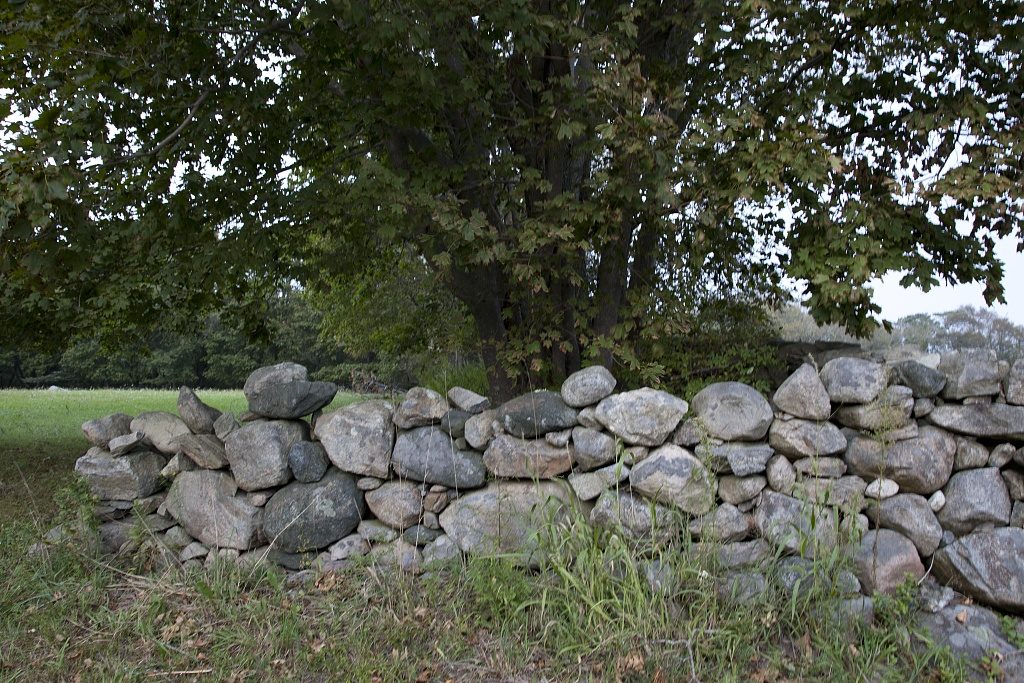
photo: Carol Highsmith, Library of Congress
Early British settlers made many of these stone walls. The settlers came here to farm. But Connecticut was covered with forests. The settlers cut down the trees to make fields and pastures. The soil was full of rocks. They piled the rocks neatly around the edges. The resulting stone walls helped keep the farm animals in a pasture and out of a field.
The cleared soil froze more deeply than the rocky soil during the winter. This led to frost heaves in the spring. The heaves lifted buried rocks toward the surface. Every year, farmers cleared more stones from their fields and added them to the walls.
Stone walls are also important because we can learn by studying the rocks that form the walls. Many of the rocks in these walls have stories!
Where Did the Rocks Come From?
How did these rocks get here? We find clues in the types of rock. Granite is one type of rock found in Connecticut. Granite is a hard, tight rock with small grains. It usually has dark and light flecks. Granite formed 500 million years ago. Pressure and heat deep underground melted the rock and then made it hard again. It later came up to the surface.
Gneiss and schist are the two most common types of rocks in Connecticut. Gneiss has clear dark and light bands. It also formed from pressure and heat. You can tell schist from gneiss because it is less banded and has a wood-like grain. These rocks formed 300 million years ago.
Over millions of years, wind and water changed the geography of Connecticut. Tiny bits of rock that water and wind rub off piled up in the Connecticut River Valley and created layered rocks. Layered rocks are called sedimentary rocks. Brownstone is a soft, reddish-brown type of sedimentary rock. Brownstone was later quarried in Portland to build buildings—including many in New York City!
All of these types of rocks show glaciation. Glaciation is when thick sheets of ice moved from the Arctic across Connecticut. The last ice sheet moved across the state 20,000 years ago. When the ice moved, so did rocks. The ice was heavy. It crushed rock into mud. It ground stone against stone. This created the stripes, or striations, we see today.
When the climate warmed and the ice melted, the water carried rock, sand, and fine soil into the river valleys. About 15,000 years ago, there was no ice left in Connecticut. There was only rocky, lifeless soil.
Tundra formed first. Tundra is a community of tiny flowers and shrubs that grows in cold, windy conditions. The climate continued to warm, and trees began to grow in the tundra.
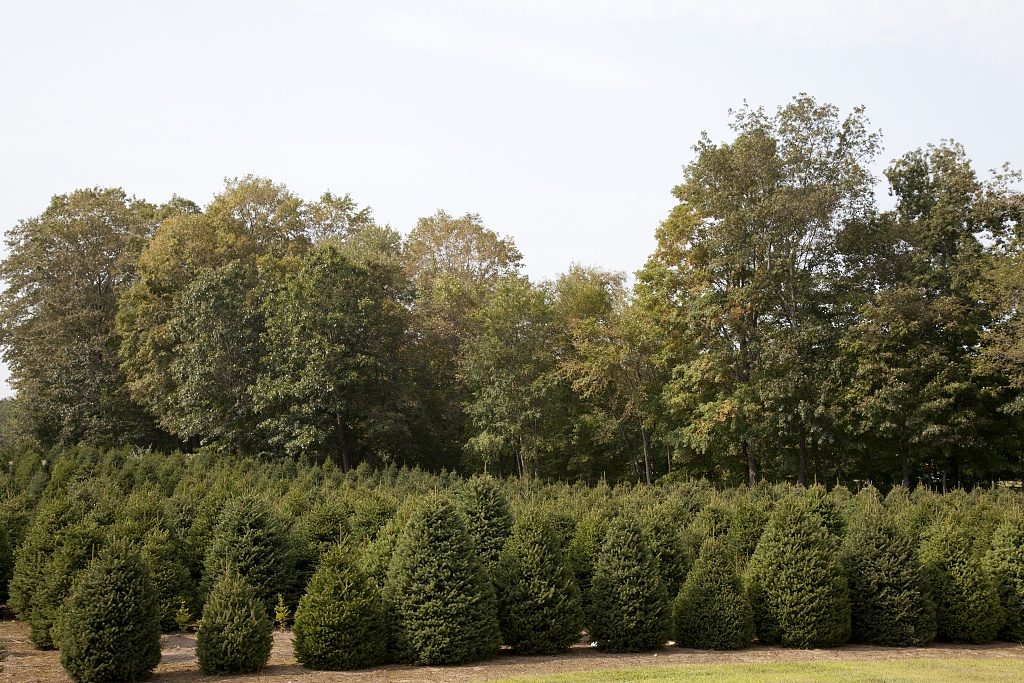
Christmas tree farm in Connecticut. photo: Carol Highsmith, Library of Congress. Conifers below and deciduous trees (trees that lose their leaves in the winter) behind.
Conifers were the first trees to grow. Examples of conifers are pine and spruce trees—think Christmas trees! Birch, oak, maples, and other kinds of green, leafy trees came next. The roots of the trees were strong. They broke apart the hard glacial soil, and the fallen leaves helped form rich, dark soil.
How Rocks Tells Us When the First Peoples Arrived
Rocks also tell us when Connecticut’s first people arrived. Native American activity goes back 10,190 years. This was when most of the trees were still conifers.
These first people built a camp in northwestern Connecticut. They built a campfire. How do we know? Archaeologists found a cracked campfire stone and a charcoal hearth. They guess that fewer than 20 people lived there, and lived there for about a month. They also think the people left and didn’t return. The people moved on to hunt for food.
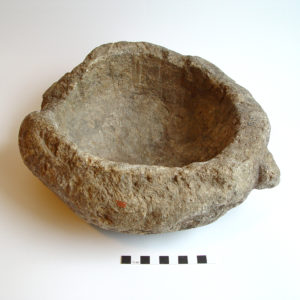
Steatite stone bowl. Connecticut State Museum of Natural History
Native Americans developed tools from stones. They used hard rocks to carve soft rock (steatite or soapstone) into bowls. Steatite is a soft type of rock that carves easily. It also conducts heat well and can be used for cooking over a fire. Steatite was quarried in the north-central and northwest part of the state.
Rocks for Industry
Northwest Connecticut had good deposits of iron ore. Iron was made in Connecticut from the ore from 1735 to 1923.
Miners dug the ore out of the earth. The ore was then heated to high temperature in a furnace built of stone. The heat separated impurities from the iron. The result was called pig iron. A blacksmith then forged the pig iron into tools.
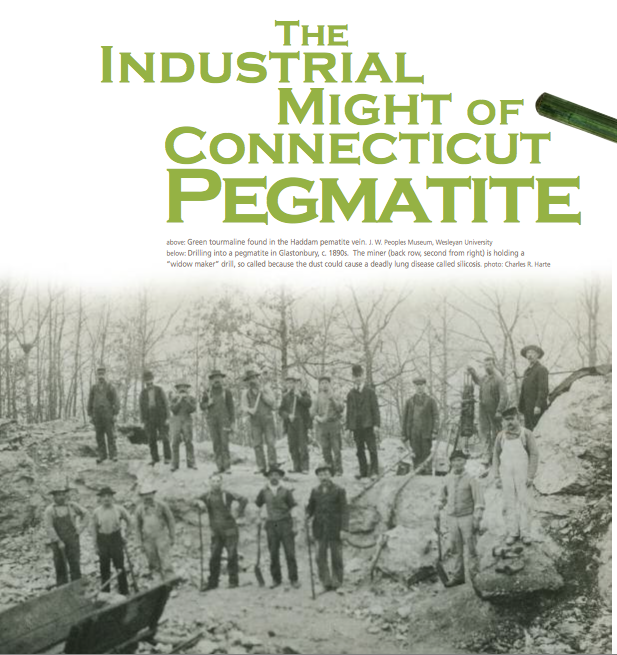
Drilling pegmatite, Glastonbury, 1890s. See httpctexplored.org/the-industrial-might-of-connecticut-pegmatite/
Pegmatite was another important mineral. Pegmatite is a granite-like rock made up of feldspar, quartz, mica, and other minerals.
Pegmatite was first mined in Connecticut before 1825 for its feldspar. The first feldspar mill was in South Glastonbury. In 1908 Connecticut was the leading producer of feldspar in the United States.
To collect feldspar, miners drilled holes in the pegmatite. They filled the holes with dynamite and blasted the rock into chunks. Big stone wheels crushed the chunks to a fine powder.
This feldspar powder was shipped to factories. It was used to make porcelain pottery, glass, cleaners, and fertilizer. One important product was poultry grit. The grit was fed to chickens to help them digest their food.
Mica and quartz are also found in pegmatite. You probably have mica in your home. It insulates the heating wires in toasters and hair driers. Quartz is important in glassmaking but has many other uses, too.
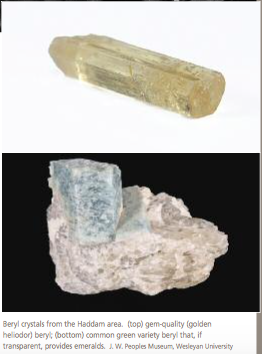
Beryl crystals from the Haddam area. J. W. Peoples Museum, Wesleyan University, see http://ctexplored.org/the-industrial-might-of-connecticut-pegmatite/
Beryl is also found in pegmatite. Beryl is used in making copper and other metals. Beryl can also be gem-quality and used in making jewelry.
Tons of the kind of beryl used for industry were mined in Connecticut. When the Feldspar Corporation closed its Connecticut division in 1991, nearly 200 years of pegmatite mining in Connecticut ended.
As you can see, there are many stories in our rocks! Find out more about Connecticut’s rocks at the Connecticut Museum of Mining and Mineral Science in Kent or the Peabody Museum of Natural History in New Haven. You will be amazed at the riches that could well be found beneath your feet.
Connecticut Museum of Mining and Mineral Science
Connecticut State Museum of Natural History
Peabody Museum of Natural History
This article was adapted from “Written in Stone” by Collin Harty, Connecticut Explored, Summer 2006, “The Kent Iron Furnace,” by Karin Peterson, Connecticut Explored, Fall 2006, and “The Industrial Might of Connecticut Pegmatite,” by John A. Pawloski, Connecticut Explored, Summer 2010.
For Teachers: Find links to these stories on the For Teachers tab, Chapter 1
GLOSSARY
Archaeologist a person who studies history through digging in the ground to find things that can tell him or her about what happened there in the past
Conifer evergreen trees and shrubs having usually needle-shaped
Conduct to help something move through something else
Frost heave ground that is raised by the process of freezing and thawing
Glaciation the effects of a large body of ice moving slowly through an area
Impurities parts of a thing that are not as good as the rest
Insulate a covering to prevent heat, electricity, or sound to pass through
Pasture land where animals get fed by eating the plants





